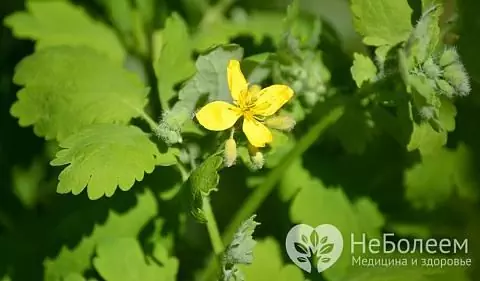- Author Rachel Wainwright [email protected].
- Public 2023-12-15 07:39.
- Last modified 2025-11-02 20:14.
Celandine poisoning
Celandine (warthog, purity, dog soap) is a ubiquitous unpretentious herb with small four-petal yellow flowers collected in inflorescences. It belongs to the Poppy family, and, like other members of this family, has both useful and poisonous properties.

Source: depositphotos.com
Celandine is actively used in folk medicine as an external agent in the treatment of skin diseases, which is reflected in its names. It has wound healing, antiseptic, antibacterial and antifungal properties, and therefore is effective in the treatment of a number of dermatitis, warts, papillomas, mycoses and eczema.
Representatives of alternative medicine prescribe their patients to take celandine preparations inside for the treatment of diseases of the gastrointestinal tract, organs of the female reproductive system, ENT organs, nervous disorders, and also as an anesthetic. Doctors do not recommend doing this - for all its useful qualities, celandine is highly toxic. It is because of its toxicity that it has antitumor properties, which healers and healers love to remind about, however, like many other anticancer agents, it acts indiscriminately, affecting not only tumor, but also healthy cells.
How does celandine poisoning occur?
Celandine contains a large amount of poisonous alkaloids: alocryptopine, coptisine, protopine, sanguinarine, chelidonine. Once inside, they affect the nervous system, liver, cause disorders of cardiovascular activity, breathing.
All parts of the plant are poisonous. Poisoning occurs when a toxic dose of celandine, a fresh plant or its juice gets inside. As a rule, this happens during treatment with celandine according to folk recipes. It is difficult to calculate the toxic dose, it is individual for each person, for traditional medicines, of course, such calculations are not carried out.
One of the popular folk methods for treating toothache, consisting in chewing celandine root, is very dangerous even if you do not swallow saliva with the released juice, but spit it out. In the roots, the concentration of poisonous alkaloids is especially high, and they are able to penetrate through the mucous membrane of the oral cavity.
Negative consequences can also occur when celandine is applied externally, as well as when its juice accidentally gets on the skin, but they are local in nature, usually without leading to serious health problems.
Poisoning symptoms
Celandine poisoning can be acute and chronic. Chronic poisoning occurs with prolonged use of a relatively small amount of celandine inside. Symptoms are usually less pronounced than in acute poisoning, but this makes it no less dangerous. The body's response to poisoning also depends on age; in children, intoxication is more severe.
Signs of celandine poisoning:
- nausea, vomiting;
- diarrhea, accompanied by severe intestinal cramps and flatulence;
- mydriasis (dilated pupils);
- heart rhythm disorders (tachycardia, arrhythmia);
- increased sweating (cold sweat);
- shortness of breath, shortness of breath, cough;
- pallor of the skin;
- fasciculation (muscle twitching);
- convulsions;
- loss of consciousness, coma.
Death occurs as a result of developing heart failure.
Signs of toxic effects of celandine when applied topically:
- dermatitis at the site of application of celandine (contact dermatitis);
- redness, rash and blistering.

Source: depositphotos.com
First aid for celandine poisoning
In case of celandine poisoning, medical attention is needed, so you should immediately call an ambulance or take the victim to the hospital on your own. Further first aid measures depend on whether the victim is conscious.
If the person is conscious:
- give him activated charcoal to drink at the rate of 1 tablet per 5 kg of weight, or any other available sorbent according to the instructions;
- observe the victim until the ambulance arrives, without leaving him alone.
If the victim is unconscious:
- check pulse and breathing. If they are absent, perform resuscitation (mouth-to-mouth breathing and chest compressions) before the arrival of an ambulance;
- if the pulse and breathing are saved, you need to lay the victim on one side and provide him with an influx of fresh air, for which you unbutton or loosen tight clothing, open a window;
- do not leave the victim alone, monitor the pulse and breathing until an ambulance arrives.
In case of accidental ingestion of celandine juice on the skin or if undesirable reactions appear during treatment with external preparations of the plant, rinse the skin area abundantly under running water.
What not to do in case of celandine poisoning:
- flush the stomach. Usually, signs of poisoning appear when celandine alkaloids have already penetrated into the blood, in addition, in case of celandine poisoning, a violation of nervous, mental, cardiovascular activity and respiration is possible, artificial induction of vomiting under these conditions can worsen the condition of the victim. Probe flushing can help, but it is done in a hospital setting.
- give the victim any medications, except for sorbents, including a laxative.
When is medical attention required?
In case of celandine poisoning, a visit to a doctor is mandatory in any case, even if the symptoms of poisoning seem insignificant - only a specialist can adequately assess the threat to health.
Inpatient treatment consists of the following measures:
- evacuation of stomach contents to remove possible residues of poison by flushing through a tube;
- maintenance of cardiovascular activity and respiration, if necessary, connection to a ventilator;
- control of the functions of the nervous system, mental state and blood glucose levels, if necessary, symptomatic therapy aimed at correcting deviations.
Possible consequences
In the absence of severe disorders of the respiratory, cardiovascular and nervous systems, the victim is discharged after 6-12 hours. To restore the body, you need to rest for several days, drink plenty of fluids, and light dietary food.
If there are disturbances in breathing, cardiac activity, nervous system, etc., the patient continues to be monitored and treated in the intensive care unit until they are eliminated.
One of the consequences of celandine poisoning can be cholestatic hepatitis, accompanied by jaundice, this condition requires hospital treatment.
In rare cases, victims of celandine poisoning cannot be saved.
Prevention
In order to prevent celandine poisoning, it is better to refuse to use it and its preparations inside. If, nevertheless, there is such a need, confirmed by a doctor, the prescribed dosage should be strictly observed. You can not take celandine and its preparations on the advice of friends, healers, healers, herbalists and other people who are not responsible for the health of their patients.
Celandine and preparations from it are prohibited for children.

Anna Kozlova Medical journalist About the author
Education: Rostov State Medical University, specialty "General Medicine".
The information is generalized and provided for informational purposes only. At the first sign of illness, see your doctor. Self-medication is hazardous to health!






